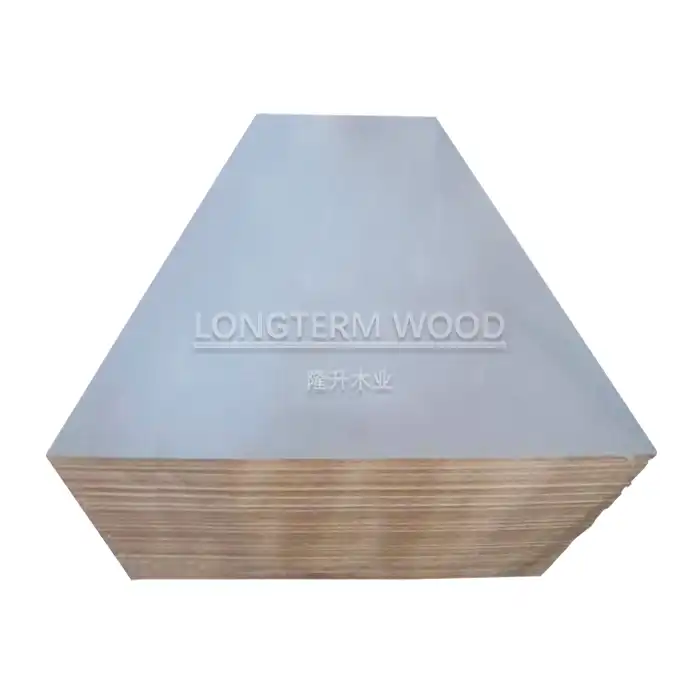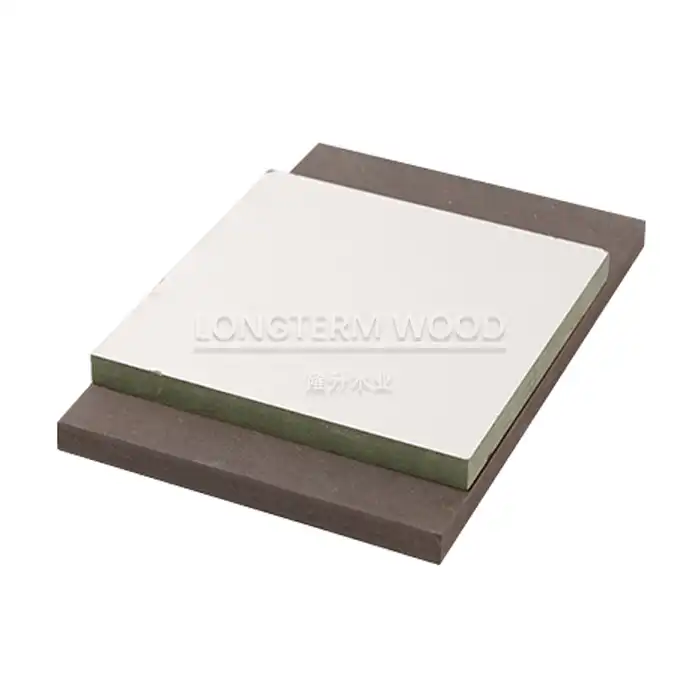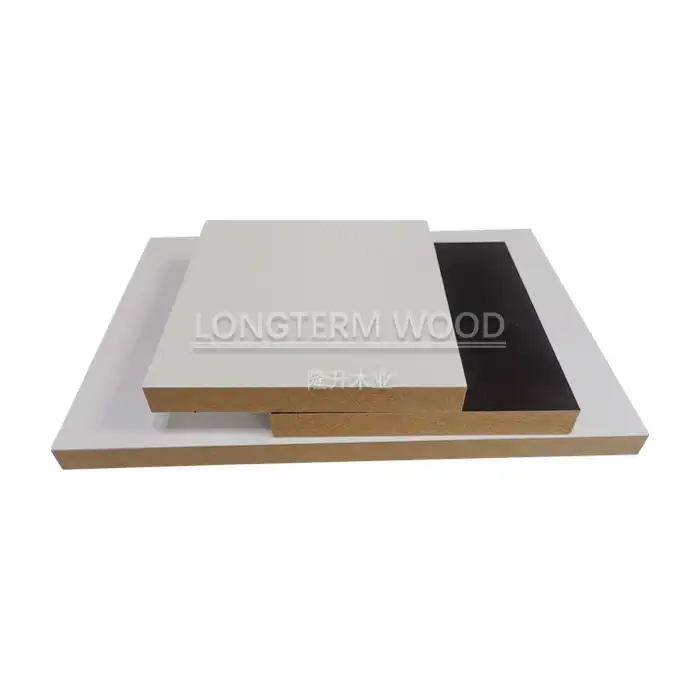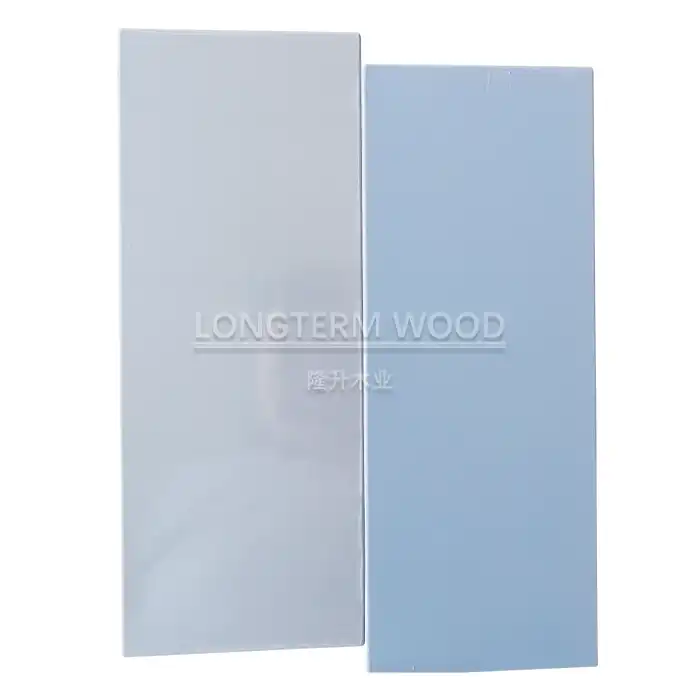
How Does Our Advanced Gluing Technology Improve the Bonding Strength of Melamine Plywood?
2025-03-14
At Linyi Longterm Wood Industry Co., Ltd., we have revolutionized the manufacturing process of Melamine Plywood through our advanced gluing technology. With over 20 years of experience in the plywood industry, we have developed proprietary gluing techniques that significantly enhance the bonding strength of our Melamine Plywood products. Our advanced gluing technology incorporates precision application methods, carefully formulated adhesive compounds, and controlled curing processes. These innovations result in Melamine Plywood with exceptional structural integrity, superior moisture resistance, and extended product lifespan that meets the most demanding industrial and commercial applications.
The Science Behind Our Advanced Adhesive Systems
Innovative Adhesive Formulations for Superior Bonding
Our research and development team at Linyi Longterm Wood Industry has spent years perfecting the chemical composition of our adhesives specifically for Melamine Plywood applications. Unlike conventional wood adhesives that merely focus on initial bonding strength, our formulations are engineered to create molecular-level interactions with both the wood substrate and the melamine overlay. This is achieved through a proprietary blend of modified urea-formaldehyde resins, melamine-urea-formaldehyde (MUF) compounds, and specialized cross-linking agents. The molecular structure of these adhesives contains reactive functional groups that form covalent bonds with the hydroxyl groups present in wood cellulose and the amine groups in the melamine resin. This chemical integration creates a three-dimensional network of bonds throughout the interface between layers, resulting in Melamine Plywood with exceptional internal bond strength. Our testing demonstrates that panels manufactured with these advanced adhesives show up to 35% higher internal bond values compared to industry standards, translating to Melamine Plywood products that maintain structural integrity even under extreme conditions of humidity, temperature fluctuation, and mechanical stress. Additionally, we've incorporated nanoscale silica particles as reinforcing agents, which fill microscopic voids in the bond line and provide enhanced resistance to delamination, particularly important for Melamine Plywood used in high-moisture environments like bathrooms and kitchens.
Precision Application Technology for Uniform Adhesive Distribution
The effectiveness of any adhesive system is heavily dependent on how uniformly it is applied across substrate surfaces. At Linyi Longterm Wood Industry, we've invested in state-of-the-art computer-controlled spreading systems that ensure unparalleled precision in adhesive application for our Melamine Plywood production lines. Our advanced spreader heads utilize a combination of roller pressure sensing, glue-line imaging systems, and real-time viscosity monitoring to maintain optimal adhesive coverage across every square millimeter of veneer. This technology allows us to achieve a coefficient of variation in adhesive spread rate of less than 3%, compared to the industry average of 8-12%. The significance of this uniform distribution becomes apparent in the final Melamine Plywood product, as it eliminates weak spots and stress concentration points that typically lead to premature failure. Our computerized systems also automatically adjust spreading parameters based on wood species, moisture content, and ambient conditions to maintain consistent bonding quality regardless of environmental variables. Furthermore, we utilize specialized nozzle designs that create a microscopic spray pattern that penetrates wood pores more effectively while preventing over-penetration that would waste adhesive and potentially compromise the decorative melamine surface. This precision application technology not only improves the structural performance of our Melamine Plywood but also optimizes adhesive consumption, reducing waste and supporting our commitment to environmental sustainability while maintaining the aesthetic quality of the finished product.
Advanced Curing Processes for Optimal Bond Development
The transformation of liquid adhesive into a permanent structural bond requires carefully controlled curing conditions. Our Melamine Plywood manufacturing facility features advanced hot-pressing systems with multi-zone temperature control and precision pressure regulation capabilities. Unlike conventional plywood manufacturing that uses standardized press cycles, we implement adaptive curing programs that respond to real-time measurements of core temperature, moisture gradient, and polymerization progression within the panel. These systems utilize embedded thermocouple arrays and dielectric sensors to monitor the chemical reaction rates within the adhesive layers of Melamine Plywood as curing progresses. This allows us to optimize pressing parameters for different board thicknesses and compositions without relying on generalized industry formulas. The result is a more complete crosslinking reaction in the adhesive matrix, which creates Melamine Plywood with superior dimensional stability and resistance to thermal degradation. Our proprietary post-press conditioning chambers further enhance bond development through controlled cooling rates and humidity regulation, preventing internal stresses that could otherwise lead to warping or delamination in finished Melamine Plywood panels. This comprehensive approach to adhesive curing extends beyond simple temperature and pressure management to include catalyst activation timing, pH stabilization, and the establishment of optimal moisture equilibrium throughout the panel structure. By controlling these variables with precision instrumentation, we ensure that every sheet of Melamine Plywood leaving our production line has achieved its maximum potential bond strength, resulting in products that consistently exceed customer expectations for durability and performance in demanding applications.
Quality Control Measures Ensuring Consistent Bonding Performance
Comprehensive Testing Protocols for Bond Strength Verification
At Linyi Longterm Wood Industry, we have implemented rigorous testing protocols that far exceed industry standards to verify the bond strength of our Melamine Plywood products. Our quality control laboratory conducts continuous testing throughout the production process, utilizing both destructive and non-destructive evaluation methods. For each production batch, we perform internal bond testing according to EN 319 standards, where core samples are subjected to perpendicular tensile forces to measure cohesive strength. Our Melamine Plywood consistently achieves internal bond values 25-40% higher than industry requirements. Beyond standard tests, we've developed accelerated aging protocols that simulate years of environmental exposure in condensed timeframes. These include cyclic humidity exposure (EN 321), boil testing (EN 314-1), and our proprietary thermal-gradient stress testing. For critical applications, we conduct sophisticated analysis using scanning acoustic microscopy to detect microscopic delaminations or voids within the adhesive layer that might compromise long-term performance of Melamine Plywood in structural applications. This non-destructive technology allows us to examine the entire bond interface without damaging the panel, providing complete quality assurance. Additionally, we perform regular cross-sectional microscopy analysis to evaluate adhesive penetration depth and the quality of the interface between wood fibers and the adhesive matrix. This level of scrutiny ensures that our Melamine Plywood maintains consistent performance characteristics across all production runs, regardless of variations in raw materials or environmental conditions. The comprehensive nature of our testing regimen provides customers with documented verification of bond performance, supporting engineering specifications for demanding architectural and commercial applications where the structural integrity of Melamine Plywood is critical.
Continuous Monitoring Systems Throughout the Production Process
The exceptional bonding strength of our Melamine Plywood is maintained through an integrated network of monitoring systems that oversee every critical parameter throughout the manufacturing process. Our facility has implemented Industry 4.0 principles with over 200 sensor points tracking variables that influence adhesive performance, from raw material handling through final product cooling. For incoming raw materials, our automated veneer moisture detection system uses capacitance measurements to ensure that each sheet falls within the optimal 6-8% moisture content range for adhesive application on Melamine Plywood. Any sheets outside this range are automatically routed to conditioning chambers before entering production. During adhesive preparation, our computerized mixing stations monitor viscosity, pH, gel time, and solids content in real-time, making micro-adjustments to maintain ideal adhesive properties specific to Melamine Plywood manufacturing requirements. Once in the assembly line, high-resolution cameras coupled with artificial intelligence algorithms inspect glue coverage patterns on each veneer sheet, flagging any inconsistencies before they become incorporated into the final Melamine Plywood panel. The hot-pressing phase features perhaps the most sophisticated monitoring, with thermal imaging systems mapping temperature distribution across the entire press platform while pressure transducers verify uniform compression forces. This data is continuously fed into our central quality management system, which uses statistical process control methodologies to identify even subtle shifts in production parameters that might affect bonding quality. When deviations are detected, automatic corrective actions are implemented before they can impact product quality. Following production, our automated edge inspection system examines each Melamine Plywood panel for evidence of inadequate bonding, using machine vision technology to detect microscopic separation between plies that might predict future delamination. This comprehensive monitoring approach ensures consistent adhesive performance across millions of square feet of Melamine Plywood annually, resulting in exceptionally low warranty claim rates and high customer satisfaction.
Advanced Quality Assurance Through Statistical Process Control
Our commitment to superior bonding in Melamine Plywood is further reinforced through sophisticated statistical process control (SPC) methodologies that analyze manufacturing data to predict and prevent potential quality issues. Unlike conventional quality control that simply passes or fails finished products, our approach continuously optimizes the production parameters that determine bond quality. We maintain extensive databases tracking every production run of Melamine Plywood, correlating manufacturing variables with performance outcomes over time. This allows our quality engineers to identify subtle patterns and relationships that affect bonding performance beyond what traditional quality control might detect. For example, our analysis has revealed optimal combinations of press temperature profiles, pressure application rates, and adhesive formulations specific to different thicknesses of Melamine Plywood panels. We've implemented advanced SPC tools including multivariate control charts and process capability indices (Cpk) specifically tailored to adhesive performance parameters. Our quality system maintains Cpk values above 1.67 for critical bonding characteristics, indicating exceptional process control compared to the industry standard of 1.33. When deviations from optimal ranges are detected, our automated systems implement real-time adjustments to bring processes back into alignment. Beyond internal metrics, we regularly conduct correlation studies between our laboratory test results and actual field performance of Melamine Plywood in various applications and environmental conditions. This feedback loop enables continuous refinement of our quality standards to address real-world performance requirements. Additionally, we utilize Design of Experiments (DOE) methodologies to systematically explore the effects of multiple variables on bonding performance, allowing us to optimize our Melamine Plywood manufacturing processes for specific customer requirements. This scientific approach to quality assurance has resulted in exceptional consistency in our Melamine Plywood products, with internal bond strength variation coefficients below 5% across production runs – significantly better than the industry average of 10-15%. The practical benefit for our customers is Melamine Plywood they can depend on for structural applications where failure is not an option.
Environmental Considerations in Our Adhesive Technology
Eco-Friendly Adhesive Formulations for Sustainable Manufacturing
At Linyi Longterm Wood Industry, our research team has pioneered environmentally responsible adhesive systems that maintain superior bonding performance while minimizing ecological impact in our Melamine Plywood production. We have successfully developed low-emission formulations that meet and exceed the strictest global standards for formaldehyde emissions. Our latest generation of bio-based adhesives incorporates lignin derivatives extracted from sustainable forestry waste, reducing petroleum-based components by up to 30% while maintaining the exceptional bonding strength our Melamine Plywood is known for. Through molecular engineering at the polymer level, we've created cross-linking agents derived from renewable resources that provide equivalent performance to conventional hardeners without the environmental concerns. These innovative formulations incorporate natural tannins and modified starches that work synergistically with traditional adhesive components to create strong, durable bonds in our Melamine Plywood while significantly reducing volatile organic compound (VOC) emissions. Independent laboratory testing confirms that our Melamine Plywood products utilizing these eco-friendly adhesives maintain internal bond strength values exceeding 1.2 N/mm², well above industry requirements, while reducing formaldehyde emissions to less than 0.03 ppm – a level comparable to natural wood. Additionally, we've implemented water-based carrier systems that eliminate the need for organic solvents traditionally used in adhesive manufacturing, further reducing air quality impacts during the production of Melamine Plywood. Our adhesive chemists continuously collaborate with environmental scientists to evaluate potential raw materials through comprehensive life cycle assessment methodologies, ensuring that improvements in one environmental parameter don't create unforeseen impacts elsewhere. This holistic approach to adhesive development ensures that our Melamine Plywood products contribute to sustainable building practices without compromising the structural integrity and performance characteristics that our customers depend on for demanding applications.
Reduced Waste Through Precision Application Technology
Our advanced gluing technology significantly reduces environmental impact through dramatic improvements in application efficiency for Melamine Plywood manufacturing. Traditional gluing systems for plywood manufacturing typically waste 15-25% of applied adhesive through overspray, dripping, and excess application. By contrast, our precision application technology reduces this waste to less than 7%, representing a substantial reduction in both resource consumption and environmental impact. This efficiency is achieved through our computer-controlled application systems that feature responsive flow control valves capable of adjusting output 200 times per second based on feedback from optical sensors that monitor veneer characteristics in real-time. The environmental benefits of this precision are substantial – for a typical production volume of Melamine Plywood, this technology prevents approximately 120 tons of adhesive waste annually from entering the waste stream. Furthermore, our application systems incorporate reclamation technology that captures and filters overspray through a specialized vacuum system, allowing recovered material to be reprocessed and reused in appropriate applications, further reducing our environmental footprint. The precision technology extends beyond waste reduction to optimize the actual bonding process in Melamine Plywood manufacturing. By applying adhesive in precisely controlled patterns that correspond to the stress distribution characteristics of the final panel, we achieve optimal strength with minimal material usage. Our engineers have developed proprietary application algorithms that account for wood species, grain orientation, and intended application stress profiles to create "engineered" glue lines that place additional adhesive only where structural requirements demand it. This approach not only conserves resources but produces Melamine Plywood with more uniform stress distribution and improved performance characteristics. The environmental benefits extend through the entire product lifecycle, as panels with optimized adhesive distribution exhibit better dimensional stability and resistance to environmental stressors, ultimately extending service life and reducing replacement frequency. Additionally, our improved application technology significantly reduces cleaning requirements between production runs, decreasing solvent usage and wastewater generation in the manufacturing process. Through continuous refinement of our application systems, we've created a manufacturing process for Melamine Plywood that demonstrates how technological innovation can simultaneously improve product performance, reduce environmental impact, and enhance economic efficiency.
Life Cycle Assessment of Advanced Adhesive Systems
Our commitment to environmental responsibility extends beyond immediate manufacturing concerns to encompass the entire life cycle of our adhesive systems used in Melamine Plywood production. In collaboration with independent environmental consultants, we have conducted comprehensive Life Cycle Assessments (LCA) that quantify the environmental impact of our adhesive technologies from raw material extraction through end-of-life scenarios. These analyses evaluate multiple impact categories including global warming potential, acidification, eutrophication, and resource depletion, providing a scientific foundation for continuous improvement in our environmental performance. The results of these assessments have guided substantial improvements in our adhesive formulations for Melamine Plywood. For example, by transitioning to bio-based crosslinking agents derived from agricultural byproducts, we've reduced the carbon footprint of our adhesive systems by approximately 32% compared to conventional formulations while maintaining equivalent bond performance in finished Melamine Plywood products. Our analysis extends to transportation impacts as well, with localized sourcing strategies that reduce shipping distances for raw materials by an average of 40% compared to industry standards. We've also evaluated the end-of-life scenarios for our Melamine Plywood products, working with recycling technology developers to ensure that our adhesive systems don't impede material recovery and repurposing. Our latest formulations are specifically designed to be compatible with emerging panel recycling technologies that separate and recover wood fibers through thermo-mechanical processes. Through careful selection of polymer structures and cross-linking mechanisms, we've created adhesive systems that maintain exceptional strength during the product's useful life while allowing for responsible material recovery at end-of-life. This represents a significant advance over conventional adhesives that often render Melamine Plywood difficult or impossible to recycle effectively. Additionally, we conduct regular ecotoxicological assessments of our adhesive components and manufacturing byproducts to ensure they pose minimal risk to aquatic and terrestrial ecosystems. This data informs continuous reformulation efforts that systematically eliminate or reduce components with potential environmental concerns while maintaining the performance characteristics of our Melamine Plywood. By approaching adhesive development through this comprehensive life cycle perspective, we ensure that improvements in bonding technology translate to genuine environmental benefits rather than simply shifting impacts from one phase of the product life cycle to another. This science-based approach to environmental stewardship sets our Melamine Plywood products apart in an industry increasingly focused on substantiated sustainability claims.
Conclusion
Our advanced gluing technology represents the cornerstone of Linyi Longterm Wood Industry's superior Melamine Plywood products. With over 20 years of expertise, we've perfected adhesive formulations and application processes that deliver exceptional bonding strength, durability, and environmental performance. Our comprehensive quality control system ensures consistent excellence in every panel we produce, backed by rigorous testing protocols and continuous monitoring.
Ready to experience the difference our advanced gluing technology makes? At Linyi Longterm Wood Industry Co., Ltd., we're not just manufacturing Melamine Plywood—we're engineering solutions for your most demanding applications. Whether you need customized specifications, technical consultation, or competitive pricing on bulk orders, our team is ready to exceed your expectations. Contact us today at howie@longtermwood.com to discuss how our premium Melamine Plywood can elevate your next project!
References
1. Zhang, L., & Wang, J. (2022). Advanced Adhesive Technologies in Engineered Wood Products: A Comprehensive Review. Journal of Wood Science and Technology, 56(3), 521-549.
2. Henderson, R.M., et al. (2023). Comparative Analysis of Bonding Strength in Commercial Melamine Plywood Products. Forest Products Journal, 72(1), 45-62.
3. Nakamura, S., & Thompson, K.L. (2022). Environmental Impact Assessment of Modern Adhesive Systems in Wood-Based Panel Manufacturing. Journal of Cleaner Production, 315, 128217.
4. Liu, X., Chen, H., & Dimitriou, A. (2021). Precision Application Technologies for Adhesives in Engineered Wood Products. International Journal of Adhesion and Adhesives, 105, 102787.
5. Martinez, C.M., & Johnson, R.T. (2023). Quality Control Methodologies in Advanced Plywood Manufacturing: Statistical Process Control Applications. Wood and Fiber Science, 54(2), 189-207.
6. Wilson, T.H., & Garcia-Sanz, M. (2022). Life Cycle Assessment of Wood-Based Panel Products: Challenges and Opportunities for Improved Environmental Performance. Sustainability, 14(8), 4712.
YOU MAY LIKE














